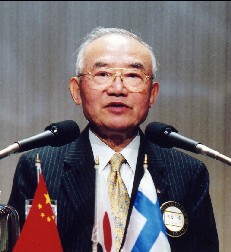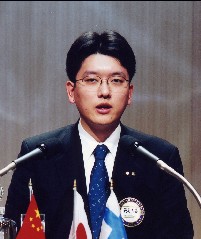"Rotarian & Rotary Magazine"
Initiation Speech
March 3rd, 2004
Mr. Akira Nagata,
Member of District Magazine Committee(Rotary-no-tomo )
Mr. Hisayoshi Zenitaka
Director and member of the Executive Committee of the Zenitaka-gumi Ltd.
 Tokyo Club member Akira Nagata, member of District Rotary-no-tomo (Official Japanese language Rotary magazine) spoke at the meeting of March3: Rotary��s by-laws stipulate the responsibilities of Rotarians which are attendance at Meetings, payment of dues, with the third being subscribing to the official Rotary organ. Therefore, I would like you to understand that reading the magazine is an important responsibility for all members.
Tokyo Club member Akira Nagata, member of District Rotary-no-tomo (Official Japanese language Rotary magazine) spoke at the meeting of March3: Rotary��s by-laws stipulate the responsibilities of Rotarians which are attendance at Meetings, payment of dues, with the third being subscribing to the official Rotary organ. Therefore, I would like you to understand that reading the magazine is an important responsibility for all members.
The reason for my speaking to you today is that this year I have been appointed a member of the District Magazine Committee, of which there are 34 members from all Japanese Rotary Districts.
Our responsibility is 1.to promote the magazine, 2.to submit reports with constructive ideas on how to better the magazine, 3.to submit articles at the request of the committee. Finally according to the request by the District Governor, to attend the 5 annual meetings of the Committee.
A meeting was held in September last year on magazine promotion, and we discussed how we can make more Rotarians read the magazine. A suggestion was made that an introduction to its contents should be placed in a home page exclusively for Rotarians. May I also remind you that the club by-laws provide for a monthly introduction to the magazine��s contents at our regular meetings.
From my professional standpoint, I believe that a committee of more then 50 members from all clubs is unwieldy, and committee reform is needed for improvement.
It is often said that the Rotary-no-tomo magazine is an unread best-seller. The reason that there are 120,000 subscriptions to the Tomo is that every Rotarian is obliged to read it as a regional official magazine, and if it is not well read, efforts must be made in its editing.
Last April, during Magazine Week we had a questionnaire sent to the 63 persons involved in our committee and all responded. Person who read the magazine from cover to cover numbered 3, those reading the greater part were 7, and partially were 44. 7 did not read the magazine but for a brief turning of pages due to lack of time, and 2 the same for other reasons.
These persons to whom the questionnaire were addressed are mainly those active in Rotary, so I must conclude that most of our members do not read the magazine at all. I believe that in comparison to the Rotarian Magazine, it is important and urgent that improvements be made in editing the Rotary-no-tomo.
 Mr. Hisayoshi Zenitaka, Director and member of the Executive Committee of the Zenitaka-gumi Ltd. gave his initiation speech on March 3: We see large scale re-development project in various places, and high rise buildings being constructed. Their scale is unprecedented, and their structures are complicated. In order to understand this phenomenon we must understand the image that we hold of humans and space.
Mr. Hisayoshi Zenitaka, Director and member of the Executive Committee of the Zenitaka-gumi Ltd. gave his initiation speech on March 3: We see large scale re-development project in various places, and high rise buildings being constructed. Their scale is unprecedented, and their structures are complicated. In order to understand this phenomenon we must understand the image that we hold of humans and space.
It is not only that we recognize physical objects such as buildings and trees. It also involves human feelings, such as what do they feel?, what do they see? We in the construction industry must understand these things and build accordingly.
Many different maps can be made frome the data given of a particular area.
These is nothing as helpful as a map in understanding an area. However, maps are made by choosing certain elements of interest, thus creating for us an image of an area.
Geographic images can be affected by experiences and education. For yourself, your image map of childhood will consist of secret byways, the local candy shop, houses where ferocious dogs were kept, and such subjective elements. In our maps of the Kanto Plain, the term ��yashiki-mori�� (residence/forest) may indicate a forest with houses, but to the foreigner, it may mean just a forest.
In the maps of our brain, information may be scarce or plentiful, and as the information source is subjective, when conversing with people we must be able to understand them by reacting to their memories also.
Regarding streets and views, there likes and dislikes, and we put these aside as being matters of taste. But aren��t we all looking at things differently?
We in the construction industry have hitherto been unheeding of the unseen local traditions and culture. By changing the street scenes and views, we are affecting local cultures and mores.
Redevelopment based on economic principles, and the preservation of street scenes based on the cherishing of old days memories present many systematic problems.
We, who offer new buildings and space must strive to have them accepted by the inhabitants and cherished by them. Is there sufficient space for evacuation when an earthquake strikes? Will people feel the streets safe when they are deserted? The big issue for the construction industry in the 21st Century is how to create a shared image of the city streets between the builders and the inhabitants.